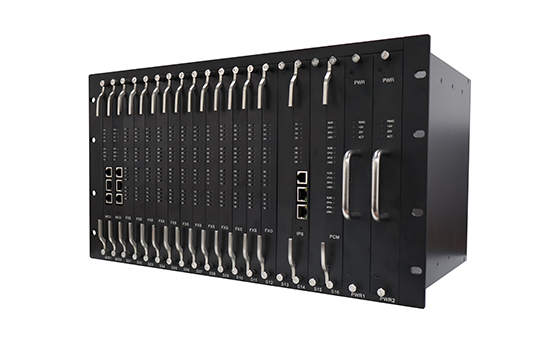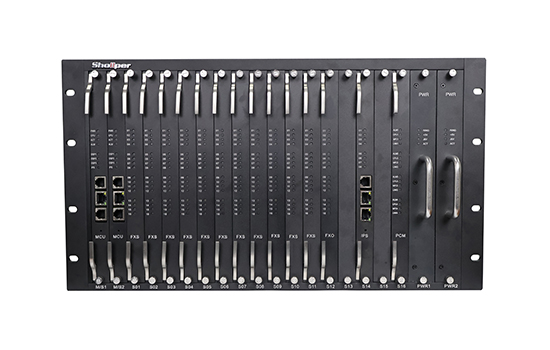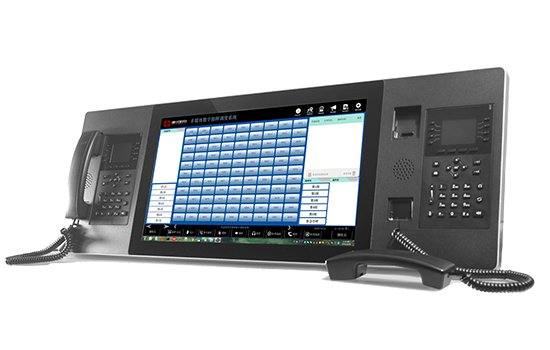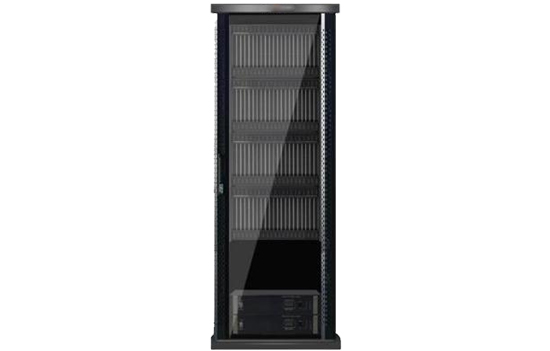



KYKX9900-D5
KYKX9900-D5The digital program-controlled dispatching machine is a new generation of intelligent multi-layer converged communication dispatching system developed by Nanjing Kangyou Kaixin Communication Equipment Co., Ltd. It features a 19-inch 5U standard chassis structure, with a maximum expandability of 3584 lines and support for up to 40 E1s. Meanwhile, it is equipped with functions of linkage dispatching across multiple systems such as video, voice, trunked intercom, broadcasting, pre-plan, alarm system, and GIS geographic information.
-
Outline
-
Functions
-
Parameters
-
Topo
KYKX9900-D5 Digital Program-controlled Dispatching Machine
Feature Highlights:
- Next-generation multimedia converged communication dispatching system
- Scalable architecture: Supports expansion from 16 channels to 3,584 channels with up to 40 E1 interfaces
- Multi-system integration: Enables dispatching across voice, video, broadcast, trunked radio, alarm, SMS, 预案,and GIS geographic information systems
- Comprehensive dispatching modes: Unified command, hierarchical control, emergency response coordination, and integrated administrative/operational management
- Group communication capabilities: Full call, group call, and team call functionalities
- One-touch operations: Instant activation for alarms, broadcasts, conferences, emergency calls, and prioritized communications
- Multi-network convergence: Seamless integration of IP, PSTN, GSM, CDMA, satellite, WiFi, WiMAX, analog/digital trunking networks for unified wired/wireless/fixed/mobile communication
- Full-channel recording: Complete capture and monitoring of all communication channels
- Real-time terminal surveillance: Continuous monitoring of all connected endpoints
- Flexible networking options: Enterprise-wide, multi-level, and multi-domain network topologies
- Bulk IP phone deployment: Efficient mass configuration and management of IP terminals
- Hot-swappable modules: Maintenance-free card replacement and hybrid hardware configurations
- Gateway functionality: Supports call routing and interconnection between diverse networks
- IP phone registration: Direct support for SIP terminal registration via IP trunk modules
- Redundant hot backup: Automatic failover protection for MCU, power supplies, and recording modules
- Extended reach: Remote user modules support terminals up to 10km away
- Unlimited console connectivity: Supports an unlimited number of dispatching consoles
- Diverse module portfolio: Includes FXS user boards, FXO/E1/EM/trunk modules, recording boards, cluster gateways, audio interfaces, broadcast systems, alarm boards, and fusion linkage modules
- Extensive terminal compatibility: Works with dispatching consoles, analog/SIP/magneto phones, WiFi devices, IP/analog cameras, microphones, headsets, amplifiers, speakers, explosion-proof phones, walkie-talkies, SOS alarms, and access control systems
- Open SDK: Provides APIs for custom application development and system integration
- Remote management: Web-based remote configuration, debugging, and maintenance for simplified deployment and operation
- Three-level lightning protection: Ensures system reliability in harsh environments
- Multiple Dispatching Modes
The dispatching system supports unified dispatching, hierarchical dispatching, emergency dispatching, etc. It can divide the entire dispatching system into multiple hierarchical dispatching systems according to enterprise conditions. Command centers at all levels can set different dispatching levels and permissions respectively. Multiple dispatching consoles can be connected to different hierarchical dispatching systems, and each system can work independently while being interconnected with each other. - Integration of Administrative and Dispatching Functions
This converged dispatching system can be used for administrative office work and also for dispatching command through the dispatching console. It can effectively integrate the enterprise information platform to realize collaborative command and dispatching, production dispatching, emergency dispatching in case of emergencies, etc. on a larger scale.
- One-key Alarm and Help Request
When staff press the help button on the phone terminal in an emergency, they can immediately call the dispatch center. The dispatch console will automatically pop up the map of the area to quickly locate the incident site, and simultaneously call the camera bound to the phone terminal. Dispatch personnel can respond to the on-site caller in the first place, which can effectively reduce the time for handling abnormalities and improve work efficiency. - Emergency Command and Dispatch
Real-time online monitoring: Enables efficient interaction and accurate and effective command and dispatch capabilities.
Emergency alarm: Quickly locks the real-time location of the alarm person and provides immediate and accurate response and handling.
Multi-channel data information transmission: Ensures smooth real-time dispatch and communication between the command center and on-duty personnel.
Multi-level dispatch: In case of emergencies, multi-level dispatch commands can be selected to achieve rapid and accurate command and dispatch for handling.
- Call Non-blocking
When multiple communication terminals initiate calls to the control center at the same time, the system can automatically queue them and display the names and numbers of the queued extensions on the dispatch console. Queued calls are processed on a first-come, first-served basis, or the dispatcher can choose to answer any of them. - Broadcast Dispatch Communication
One-key broadcast: In case of emergencies, relevant mechanisms can be triggered manually with one key (or automatically), so that the broadcast is immediately forced to switch to the emergency broadcast state, and emergency broadcasts are made to the required areas. It can quickly guide personnel to handle accidents, command orderly evacuation, and avoid greater losses caused by disasters. It also has alarm linkage and video linkage functions.
- Support for Full Call, Group Call, and Team Call
The full call function enables all terminals in the system to ring or broadcast, including broadcast terminals. In case of emergencies, it can notify all personnel immediately. The dispatcher's group calls and team calls are not restricted by the existing organizational structure, allowing personnel from different positions to be grouped into call teams. - Video Surveillance Linkage
Cameras in the work area can be bound to nearby intercom terminals or extension terminals.1.When the dispatcher clicks to call the terminal on the dispatch console, the real-time 画面 of the camera bound to the terminal will pop up directly in the monitoring area of the dispatch console, making it easier for the dispatcher to understand the situation intuitively.2.When staff use an extension terminal to call the dispatch center, the dispatch console will also automatically call up the real-time 画面 of the camera bound to the terminal.

Pre-plan Dispatching
When an emergency (such as an explosion, collapse, or excessive carbon monoxide levels) occurs in a certain area and triggers preset conditions, the system can automatically activate the handling plan. For example: it can automatically play broadcasts, automatically make calls to phones or mobile phones, or send text messages to relevant responsible persons and superior leaders.

- Voice Dispatching
Dispatchers can initiate individual calls, group calls, and team calls to all members in the system. They also have dispatching capabilities such as call intrusion, call disconnect, call pickup, monitoring, call muting, call transfer, and hotline calls, ensuring that dispatchers can issue instructions to grassroots personnel at the fastest speed. - Alarm Linkage
Alarm prompt voices can be recorded into the dispatching system (supporting the access of fire alarm systems). When corresponding conditions are triggered, the system can play the corresponding alarm prompt voices.
Trunked Intercom
Supports hybrid intercom networking such as wired and wireless.
Various terminals such as landlines and mobile phones can communicate with walkie-talkies.
Supports walkie-talkies to call the broadcast system and trigger preset broadcast voices.
Supports dial-up intercommunication and one-key intercom calls.
Supports various models and standards of walkie-talkie vehicle stations and hand-held stations.

GIS Geographic Information
It can be linked with the personnel positioning system and GIS system. When an intercom terminal calls the dispatch center, in addition to the ringing of the dispatch console phone in the dispatch center, the console can directly display the caller's number, name, and location. Alternatively, the desired hierarchical terminal can be contacted with one click via the GIS map on the dispatcher.

- Rapid Construction of Emergency Dispatch Platform
Both the dispatch host and terminals support deployment in rescue command vehicles or any location with network coverage. They can be connected to the converged communication dispatch system simply by accessing the network, effectively improving the rescue efficiency of relevant departments. - Conference Calls
Supports simultaneous conferences with various terminals, including internal/external IP phones, regular phones, industrial phones/stations, explosion-proof phones/stations, walkie-talkies, and mobile phones.
Supports initiating conferences in multiple ways such as temporary 召集 and fixed groups.
The number of conference participants can reach 128, with more than 64 full-duplex speaking channels.
The dispatch console supports one-key conference initiation.
- Flexible Networking
Supports enterprise networking, multi-level networking, and multi-domain networking. The dispatch host can be located in a public network or private network and supports NAT/Firewall traversal, facilitating various networking needs as well as remote installation, debugging, and management. - Emergency Communication Guarantee
In some remote operation areas, once the traditional communication link is interrupted and external calls cannot be made, the system can automatically switch to backup communication links (including 4G/5G networks, satellite communication networks, etc.) to contact the outside world. - Monitoring and Real-time Surveillance
The dispatch center can conduct real-time monitoring of any intercom terminal or extension terminal in the mining area through the visual dispatch console, call up surveillance feeds, and monitor on-site conditions at various points. If an emergency is detected, it can actively initiate broadcast announcements through the dispatch system. - Redundant Hot Backup
Key components of the KYKX9900 program-controlled dispatch machine, such as the MCU main control board, primary power supply box, secondary power supply board, and recording board, all support redundant hot backup, effectively ensuring the safe and stable operation of the entire system. - Diverse Dispatch Consoles with Unlimited Access
To meet the needs of various users, the KYKX9900 program-controlled dispatch machine can be connected to touch-screen dispatch consoles (single-screen, dual-screen, triple-screen, etc.) and handheld mobile dispatch consoles, satisfying users' dispatch requirements in various network environments such as wired and wireless.

- Terminal Fault Detection Function
When an extension terminal in the system goes offline due to line failure or phone malfunction, the system automatically detects the problem and sends the terminal offline information to the dispatch console, facilitating the dispatcher's further handling. - Call Recording
The KYKX9900 program-controlled dispatching machine uses a recording board to record all calls in the system. Recordings can be queried and replayed without the need for an additional recording system. The standard configuration provides a recording duration of 30,000 hours, and the recording board supports redundant hot backup. - Diversified Access Terminals
Dispatch consoles, analog/SIP/magneto phones, WiFi mobile phones, IP/analog cameras, microphones, headsets, analog/network power amplifiers, network sound columns, speakers, industrial phones, explosion-proof phones, walkie-talkies, SOS alarms, access control systems, etc.

Technical Parameters
Digital Standard: Digital time-division A-law 2.048Mb/s PCM system
Switching Network: 2048×2048 non-blocking single T-network interface for internal and external lines
Transmission Characteristics:
Extension to extension: 2~7dB
Extension to trunk: 2~7dB
Dialing Modes: Pulse, tone
Pulse Reception:
Pulse speed: 8~14 pulses/second
Pulse interval: ≤350ms
Pulse Transmission:
Pulse speed: 10±1 pulses/second
Pulse on-off ratio: (1.6±0.2):1
Trunk User Secondary Dialing:
Pulse speed: 10~12 pulses/second
Acceleration: <10%
Reception Level:
For dual-tone input: Single-tone reception level range -4~23dBm; dual-tone level difference ≤6dB
Crosstalk Attenuation: >70dB (1100Hz)
Steady Noise: ≤-65dBm
Non-steady Noise: ≤-40dBm
Traffic Volume:
User: 0.2Erl
Trunk: 0.7Erl
Call Loss Rate:
Internal calls: <1%
Outgoing calls: <0.5%
Unbalance to Earth:
300~600Hz: ≥40dB
600~3400Hz: ≥46dB
User Feeding Current: ≥18mA
Loop Resistance: R≤1KΩ
Insulation Resistance: R≥20KΩ
Line Capacitance: C≤0.5µF
Power Supply Noise: ≤2.4mV
Power Supply:
AC: 220V±20% 50Hz±2Hz
External: 48V 20~100AH storage battery
Single Frame Power Consumption: 50W~250W (depending on system configuration)
Operating Environment:
Temperature: 0~36℃
Relative humidity: 35%~75%
Host Dimensions: 483mm (width) × 307mm (depth) × 266mm (height)

- Prev: First
- Next: KYKX9900-D3






